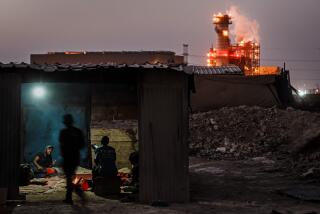Nomads Surrendering to 20th Century Temptations : Bedouin Life Style Rapidly Disappearing in the Desert
- Share via
MANAMA, Bahrain — Ever since the first European explorer set foot on the sands of Arabia, the Bedouin and his restless lifestyle have been romanticized in the West.
Through the writings of T.E. Lawrence and others, the West acquired an image of the robed Bedouin swaying across the desert on his camel, spending his nights in a goat-hair tent--a “hair house,” in Arabic--and fighting off marauding tribes with dagger and sword.
Yet tourists to Bahrain, where the Khalifa clan of the Anizah tribe once roamed, asking to visit a Bedouin village would find, as the minister of tourism said: “There aren’t any. . . . We’ve had oil for 50 years now, and that lifestyle just doesn’t exist here any more.”
Indeed, Bahrain is probably the only Arab country where the Bedouin has been totally assimilated, where the Bedouin culture has ceased to exist.
Elsewhere in the Mideast and North Africa, taps is also being sounded for these desert nomads, who are surrendering, not unwillingly, to the temptations of the 20th Century.
Jordan’s Bedouin population has declined from 200,000 in the 1950s to fewer than 50,000 today. Saudi Arabia’s is down from 1.9 million in 1974 to about 500,000; the Saudis have brought tens of thousands into the mainstream of society by bringing water, health clinics and schools to the tribal areas, called diras . Supercities in the United Arab Emirates have reduced the number of Bedouins there to hardly more than a handful of die-hard traditionalists.
Sociologists agree that the virtual disappearance of the Bedouin is probably only a generation or two away.
The consequences are not yet entirely clear, but the Arabs surely will be losing an important part of their culture, for the Bedouin has had an impact on nearly every aspect of life in the Arab world, influencing the region’s language, mentality and traditions.
The famous Arab hospitality is really Bedouin hospitality, a strict code that dominated all social relationships. Living in an environment of desperate harshness, the Bedouin offered food and lodging for three days to any visitor, friend or foe, who entered his tent. When the three days ended, the visitor was allowed to leave in peace, although on the fifth day he might again become the enemy.
Traditionally, the true Bedouin was a camel herdsman of the Arabian, Syrian or North African desert who built his herds by breeding and raiding neighboring tribes. The smaller tribes based their economies on goats and sheep, and all wandered across vast tracts of wasteland in search of grazing land and water holes. Sometimes grazing agreements were worked out between the tribes; more often than not, though, the strongest simply took what it wanted.
Drought across parts of North Africa and the Mideast in the last 15 years has forced many to forsake the nomadic Bedouin life in favor of the city, but the biggest force for change has been oil. Oil produced the sparkling new urban centers, enabled governments in the gulf region and Saudi Arabia to give free houses to all those who asked and provided the means for herdsmen to trade in their camels for small Japanese-made pickup trucks.
Shortly after World War II, the British writer-explorer Wilfred Thesiger, who had crossed the Arabian Peninsula by camel and on foot, asked in his book “Arabian Sands” if the Bedouin would be better off once he had exchanged the hardship of desert poverty for the security of urban materialism. His conclusion was that he would not.
“I shall always remember,” he wrote, “how I was humbled by those illiterate herdsmen who possessed, in so much greater measure than I, generosity and courage, endurance, patience and lighthearted gallantry. Among no other people have I felt the same sense of personal inferiority.”
More to Read
Sign up for Essential California
The most important California stories and recommendations in your inbox every morning.
You may occasionally receive promotional content from the Los Angeles Times.













